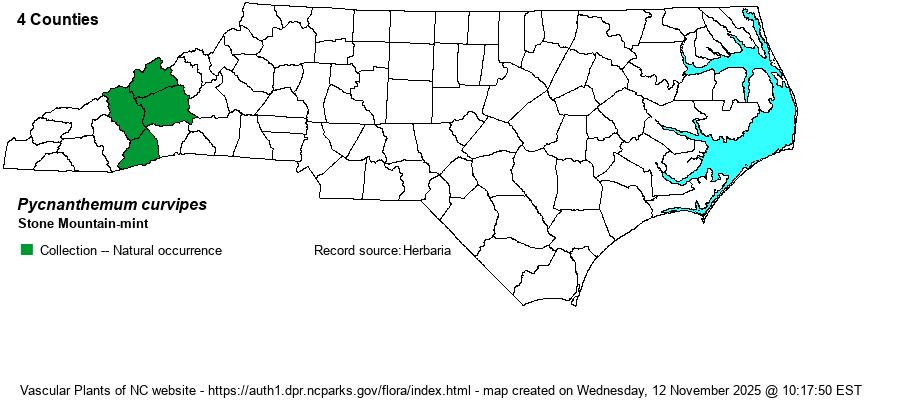| Author | (Greene) E. Grant & Epling | |
| Distribution | This is a relatively newly described species in NC, formerly native just to TN and GA; it was not listed in RAB (1968). It is a very poorly known species in NC, thus far known from recent specimens for four counties in the central Mountains, plus other sightings in those counties. However, as most specimens are from one person, it is clear that this species is not nearly as rare as suggested and that most botanists have overlooked it. Presumably it occurs farther to the southwest in the Mountains, based on its overall range.
Weakley (2018) gives its range as "Sw. NC and se. TN south [to] nc. GA and n. AL; disjunct in nc. TN". | |
| Abundance | Completely unknown, as so few botanists know this species. The NCNHP tracks the species as Significantly Rare, and gives nine records, all extant. The NCNHP gives the species a State Rank of S2. | |
| Habitat | Weakley (2018) gives the habitats as "Dry rocky woodlands and rock outcrops (granite or mafic)". Most NC records seem to be from natural areas, such as granitic domes or exposed rock outcroppings over high pH soils. | |
| Phenology | Blooms from June to August, and fruits shortly after flowering. | |
| Identification | This Pycnanthemum grows to about 3 feet tall, with many branches. Photos online show quite wide leaves with rather obtuse tips, and which are mostly quite glaucous, even those well below the inflorescence. Weakley (2018) says that this species has "Petioles 5-15 mm long; inflorescences corymbose, loose, the branches apparent". Wofford (1989) has the following characters in his key: "Stem faces and angles pubescent", "Shortest calyx lobes less than 1.1 mm long"; "Calyx nearly regular, the teeth of essentially uniform length"; and "Lower surface of leaves canescent, sharply contrasting with the darker upper surfaces". The best visual characters are that the inflorescences are not in as many small and tight heads (about 1/2-1-inch across) as the others, but are in larger ones, in a corymb, not as densely flowered as other species, and where pedicels can be seen within the corymb. The effect is a somewhat bushier look to the plant and with wider flower clusters, fairly wide leaves with broad tips, and glaucous foliage. | |
| Taxonomic Comments | None
| |
| Other Common Name(s) | None | |
| State Rank | S2 | |
| Global Rank | G3 | |
| State Status | SR-T | |
| US Status | | |
| USACE-agcp | | |
| USACE-emp | | |

